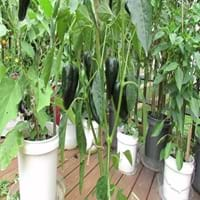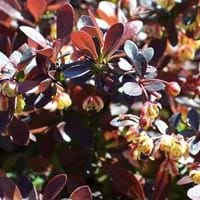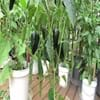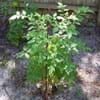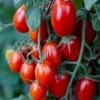Life Span
Perennial
Perennial
Origin
Mexico, Central America, South America
Japan
Types
Pasilla Bajo Pepper, Ancho Magnifico pepper
not available
Number of Varieties
Not Available
Habitat
Fertile bottom land
All sorts of environments
USDA Hardiness Zone
4-12
4-8
Sunset Zone
A1, A2, A3, H1, H2, 1a, 1b, 2a, 2b, 3a, 3b, 4, 5, 6, 7, 8, 9, 10, 11, 12, 13, 14, 15, 16, 17, 18, 19, 20, 21, 22, 23, 24
A3, 2b, 3a, 3b, 4, 5, 6, 7, 8, 9, 10, 11, 12, 13, 14, 15, 16, 17, 18, 19, 20, 21, 22, 23, 24
Habit
Upright/Erect
Oval or Rounded
Flower Color
Yellow, Gold
Yellow, Yellow green
Flower Color Modifier
Bicolor
Not Available
Fruit Color
Yellow, Orange
Red
Leaf Color in Spring
Dark Green
Crimson, Dark Red
Leaf Color in Summer
Purple, Gray Green
Dark Red, Bronze
Leaf Color in Fall
No
Red, Dark Red, Bronze
Leaf Color in Winter
Green, Dark Green
Not Available
Leaf Shape
Oval
Acuminate
Plant Season
Not Available
Spring, Summer, Fall, Winter
Sunlight
Full Sun
Full Sun, Partial Sun
Type of Soil
Loam
Clay, Loam, Sand
The pH of Soil
Acidic, Neutral
Acidic, Neutral, Alkaline
Soil Drainage
Well drained
Average
Bloom Time
Not Available
Spring, Late Spring
Tolerances
Drought
Pollution, Drought, Salt, Soil Compaction
Where to Plant?
Container, Ground, Pot
Ground, Pot
How to Plant?
Seedlings
Cuttings
Plant Maintenance
Medium
Medium
Watering Requirements
Average Water Needs, Do Not over Water, Requires regular watering
Average Water Needs
In Summer
Average Water
Lots of watering
In Spring
Moderate
Moderate
In Winter
Average Water
Average Water
Soil pH
Acidic, Neutral
Acidic, Neutral, Alkaline
Soil Type
Loam
Clay, Loam, Sand
Soil Drainage Capacity
Well drained
Average
Sun Exposure
Full Sun
Full Sun, Partial Sun
Pruning
Remove damaged leaves, Remove dead branches, Remove dead leaves, Remove dead or diseased plant parts, Remove deadheads
Prune if you want to improve plant shape, Remove damaged leaves, Remove dead branches, Remove dead leaves
Fertilizers
All-Purpose Liquid Fertilizer
All-Purpose Liquid Fertilizer
Pests and Diseases
Red blotch
Free of serious pests and diseases
Plant Tolerance
Drought
Drought, Pollution
Flowers
Insignificant
Insignificant
Flower Petal Number
Single
Single
Foliage Texture
Medium
Medium
Foliage Sheen
Glossy
Glossy
Allergy
Skin irritation
Unknown
Aesthetic Uses
Not Used For Aesthetic Purpose
along a porch, deck or patio, Borders, Cottage Garden, Informal Hedge, Ornamental use
Beauty Benefits
Not Available
Not Available
Environmental Uses
Air purification
Air purification
Medicinal Uses
Anti-oxidant, Cold, Improve circulation, Swelling, Upset stomach, Weight loss
No Medicinal Use
Part of Plant Used
Fruits
Not Available
Other Uses
Used As Food
Showy Purposes
Used As Indoor Plant
Yes
No
Used As Outdoor Plant
Yes
Yes
Garden Design
Container, Edible, Herb / Vegetable, Mixed Border, Tropical
Container, Edging, Foundation, Hedges, Mixed Border, Rock Garden, Wall
Botanical Name
CAPSICUM annuum 'Guajillo'
BERBERIS thunbergii f. atropurpurea 'Crimson Pygmy'
Common Name
Chile Negro, Holy Mole Chile, Poblano Pepper
Japanese Burberry
In Hindi
Poblano pepper plant
crimson pygmy
In German
Poblano Pfefferpflanze
crimson pygmy
In French
Poblano Pepper usine
crimson pygmy
In Spanish
planta de pimiento poblano
crimson pygmy
In Greek
φυτό πιπέρι poblano
crimson pygmy
In Portuguese
Poblano planta da pimenta
crimson pygmy
In Polish
Poblano papryka roślin
crimson pygmy
In Latin
Poblano piperis herba
crimson pygmy
Phylum
Magnoliophyta
Magnoliophyta
Class
Magnoliopsida
Magnoliopsida
Order
Solanales
Ranunculales
Family
Solanaceae
Berberidaceae
Clade
Angiosperms, Asterids, Eudicots
Angiosperms, Eudicots
Tribe
Capsiceae
Not Available
Subfamily
Solanoideae
Not Available
Number of Species
Not Available
Season and Care of Poblano Pepper and Crimson Pygmy
Season and care of Poblano Pepper and Crimson Pygmy is important to know. While considering everything about Poblano Pepper and Crimson Pygmy Care, growing season is an essential factor. Poblano Pepper season is Not Available and Crimson Pygmy season is Not Available. The type of soil for Poblano Pepper is Loam and for Crimson Pygmy is Clay, Loam, Sand while the PH of soil for Poblano Pepper is Acidic, Neutral and for Crimson Pygmy is Acidic, Neutral, Alkaline.
Poblano Pepper and Crimson Pygmy Physical Information
Poblano Pepper and Crimson Pygmy physical information is very important for comparison. Poblano Pepper height is 45.00 cm and width 90.00 cm whereas Crimson Pygmy height is 45.70 cm and width 61.00 cm. The color specification of Poblano Pepper and Crimson Pygmy are as follows:
Poblano Pepper flower color: Yellow and Gold
Poblano Pepper leaf color: Dark Green
Crimson Pygmy flower color: Yellow and Yellow green
- Crimson Pygmy leaf color: Crimson and Dark Red
Care of Poblano Pepper and Crimson Pygmy
Care of Poblano Pepper and Crimson Pygmy include pruning, fertilizers, watering etc. Poblano Pepper pruning is done Remove damaged leaves, Remove dead branches, Remove dead leaves, Remove dead or diseased plant parts and Remove deadheads and Crimson Pygmy pruning is done Prune if you want to improve plant shape, Remove damaged leaves, Remove dead branches and Remove dead leaves. In summer Poblano Pepper needs Average Water and in winter, it needs Average Water. Whereas, in summer Crimson Pygmy needs Lots of watering and in winter, it needs Average Water.
